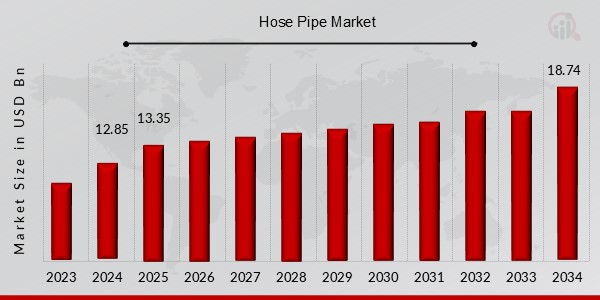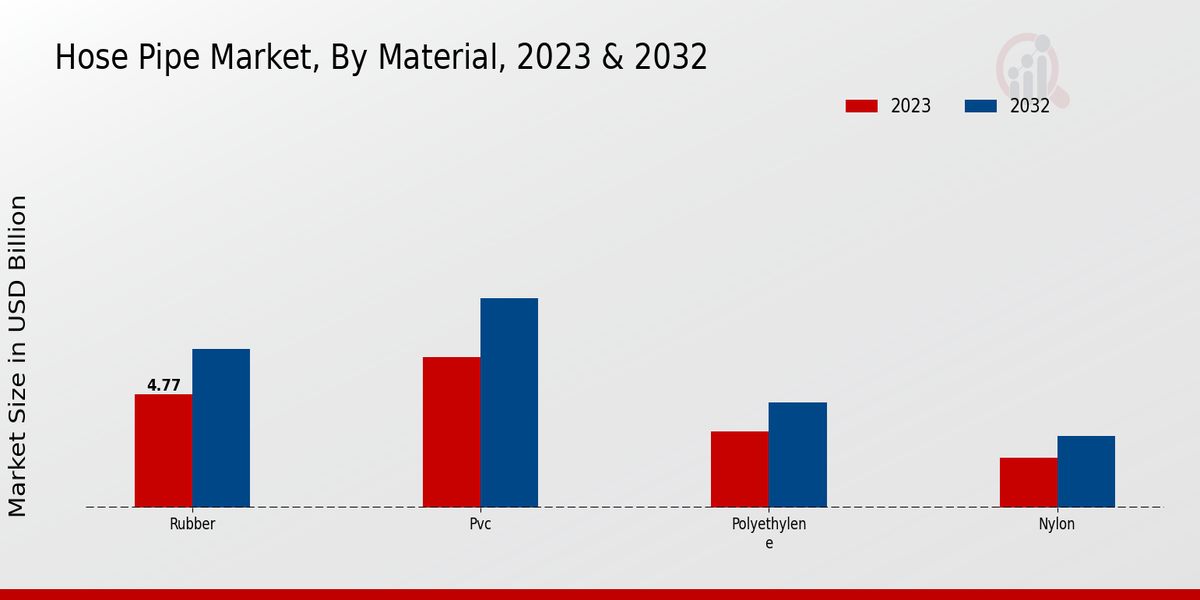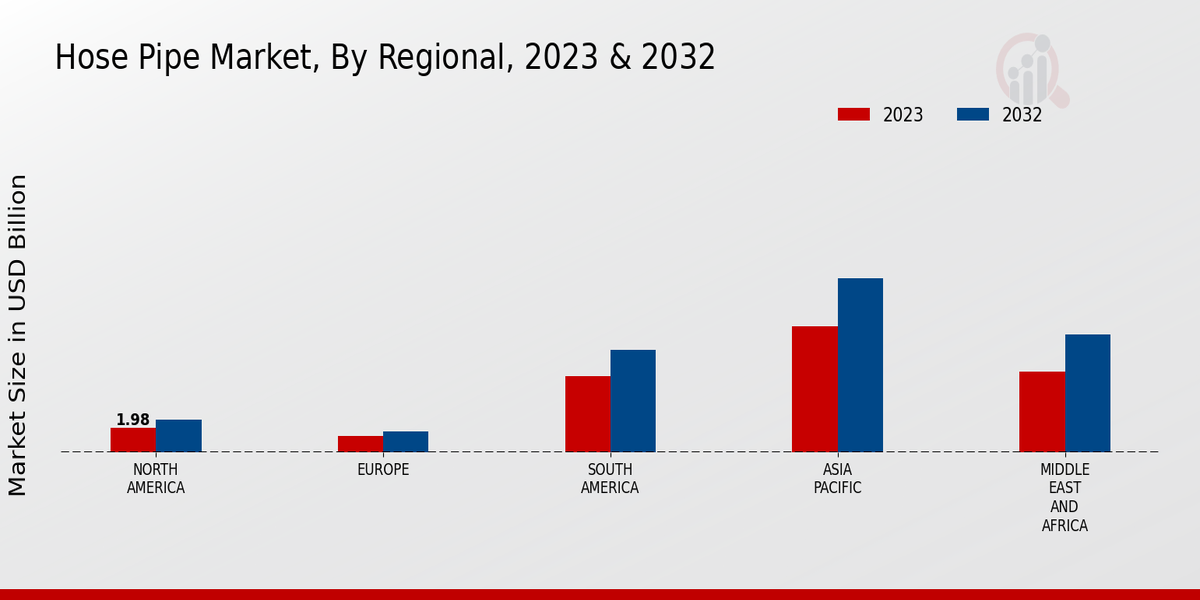Global Hose Pipe Market Overview
The Hose Pipe Market Size was estimated at 12.85 (USD Billion) in 2024. The Hose Pipe Industry is expected to grow from 13.35 (USD Billion) in 2025 to 18.74 (USD Billion) by 2034. The Hose Pipe Market CAGR (growth rate) is expected to be around 3.8% during the forecast period (2025 - 2034).
Key Hose Pipe Market Trends Highlighted
Technological advancements in materials science, such as the development of lightweight and durable polymers, have increased the efficiency and performance of hose pipes. Sustainability concerns and environmental regulations are driving the adoption of eco-friendly materials and manufacturing processes. The increasing demand for automated irrigation systems in agriculture and landscaping has fueled the growth of the hose pipe market. Emerging applications, such as fire protection, mining, and construction, are creating new opportunities for hose pipe manufacturers. The trend towards smart technologies and connected devices is enabling the development of innovative hose pipes with integrated sensors and remote monitoring capabilities. Customization and personalization are also gaining traction as customers seek hose pipes tailored to their specific needs and preferences.

Source: Primary Research, Secondary Research, MRFR Database and Analyst Review
Hose Pipe Market Drivers
Rising Demand for Agricultural Irrigation
Globally, agriculture is still the largest consumer of hose pipes, and water for irrigation covers a significant part of it. The growth of the irrigated area is due to the need to provide a growing population with food and, accordingly, increase the efficiency of agricultural technologies, including in the field of use of hose pipes. In addition, demand is growing as a result of investments by governments and organizations around the world in agricultural infrastructure in order to increase crop yields and thereby ensure food security. The consumption of hose pipes in agriculture is also stimulated by the development of new types of irrigation, such as drip irrigation using drip irrigation belts, micro-sprinkler irrigation, etc.
Growing Construction and Infrastructure Development
Hose pipes are widely used in the construction industry as pipe systems for water transportation, drainage, and cleaning. The present growth of the construction sector worldwide will enhance the demand for hose pipes. In more detail, urbanization and the increasing population in many parts of the world led to the growth of the construction market and enhanced the demand for hose pipes as an important tool for the transportation of water and other fluids. The growth of the construction industry also allows lubricant producers to seek new ways of handling fluids. Moreover, the development of the sector stimulates the creation of new types of pipe systems; recently, there has been a tendency to the development of eco-friendly hose pipes produced from recycled materials
Expanding Industrial Applications
Hose pipes have extensive use in various industrial sectors, including manufacturing, mining, and oil and gas. They are employed for fluid transfer, cleaning, and cooling purposes. The growing industrialization and automation across the globe are contributing to the increased demand for hose pipes in industrial applications. The adoption of high-pressure hose pipes for specialized industrial processes is also driving market growth. Furthermore, the increasing demand for lightweight and flexible hose pipes for industrial applications is further fueling market expansion.
Hose Pipe Market Segment Insights
Hose Pipe Market Material Insight
The Hose Pipe Market is segmented by material into rubber, PVC, polyethylene, and nylon. Rubber held the largest market share in 2023, accounting for over 40% of the total market revenue. This dominance is attributed to the material's inherent flexibility, durability, and resistance to chemicals, making it suitable for a wide range of applications, including industrial, construction, and agricultural sectors. PVC is projected to witness a steady growth rate during the forecast period, owing to its cost-effectiveness, lightweight, and ease of installation.
Polyethylene is gaining traction in the market due to its strength, resistance to corrosion, and ability to withstand high temperatures. Nylon, with its exceptional tensile strength and abrasion resistance, is expected to find increasing use in high-pressure applications. The Hose Pipe Market is expected to reach USD 12.56 billion by 2024, exhibiting a CAGR of 4.1% during the forecast period (2023-2032). The rising demand for hose pipes in various end-use industries, such as construction, agriculture, and manufacturing, is driving market growth.
The increasing adoption of lightweight and flexible hose pipes, along with the growing emphasis on safety and durability, is further contributing to market expansion. The market is also witnessing technological advancements, such as the development of reinforced and composite hose pipes, which offer enhanced performance and extended service life. In terms of regional analysis, Asia Pacific accounted for the largest share of the Hose Pipe Market in 2023 and is projected to maintain its dominance throughout the forecast period. The region's rapid industrialization and urbanization, coupled with the growing demand from the construction and automotive sectors, are key factors propelling market growth.North America and Europe are other significant markets for hose pipes, driven by the presence of established construction and manufacturing industries. The Middle East and Africa region is expected to witness a notable growth rate, owing to the increasing investment in infrastructure development and oil and gas exploration activities.
 Source: Primary Research, Secondary Research, MRFR Database and Analyst Review
Source: Primary Research, Secondary Research, MRFR Database and Analyst Review
Hose Pipe Market Application Insights
The Hose Pipe Market is segmented based on application into Gardening, Construction, Automotive, and Industrial. Among these, the Gardening segment is expected to hold the largest market share in 2023 and is projected to dominate throughout the forecast period. This is due to the increasing interest in gardening and the increasing trend of an efficient irrigation system. The Construction Segment is expected to exhibit significant growth over the forecast period due to increased construction in various geographies. The Automotive Segment is expected to hold a stationary market share as a considerable number of customers prefer to use hoses for vehicle maintenance and repair.The Industrial Segment is expected to have significant growth as hoses gain importance and use in various industries.
Hose Pipe Market Hose Type Insights
The Hose Pipe Market is segmented by Hose Type into Flex Hoses, Non-flex Hoses, and Specialty Hoses. In 2023, the Flex Hoses segment accounted for the largest market share of around 45%. Flex Hoses are highly flexible and can be used in a wide range of applications, including water distribution, gardening, and industrial cleaning. The Non-flex Hoses segment is expected to grow at a CAGR of 3.5% during the forecast period, reaching a market value of USD 5.6 billion by 2032. Non-flex Hoses are used in applications where flexibility is not required, such as in construction and mining.The Specialty Hoses segment is expected to grow at a CAGR of 4.2% during the forecast period, reaching a market value of USD 2.8 billion by 2032. Specialty Hoses are used in specialized applications, such as in the food and beverage industry and in medical applications.
Hose Pipe Market Size Insights
The Hose Pipe Market is segmented by size into small diameter (~1/2 inch), medium diameter (~1-2 inches), and large diameter (~2 inches or more). The small-diameter segment is expected to account for the largest share of the market in 2023, with a significant portion of revenue generated from applications in residential and commercial buildings. The medium-diameter segment is projected to grow at a steady pace, driven by increasing demand from the industrial and agricultural sectors. The large-diameter segment is expected to witness a surge in demand from infrastructure and construction projects, particularly in developing regions. Overall, the Hose Pipe Market is anticipated to continue its growth trajectory, with the rising adoption of advanced materials and technologies fueling market expansion.
Hose Pipe Market End-Use Insights
Hose Pipe Market segmentation is essential for understanding its dynamics and growth. Residential, commercial, and industrial sectors are the key end-use segments of the Hose Pipe Market. The residential sector accounted for the largest share of the Hose Pipe Market revenue in 2023. It is projected to maintain its dominance throughout the forecast period, driven by increasing urbanization, rising disposable income, and growing demand for home improvement projects. The commercial sector is anticipated to witness significant growth, fueled by the expansion of the hospitality, retail, and healthcare industries. The industrial sector is expected to grow steadily, supported by the growing demand for hoses in manufacturing, mining, and construction activities.
Hose Pipe Market Regional Insights
The regional segmentation of the Hose Pipe Market offers insights into the performance of the market across different geographic regions. North America is anticipated to hold a significant share of the market in 2023, owing to the presence of major players and high demand from end-use industries. Europe is also expected to contribute a substantial portion to the market, driven by regulations and technological advancements. Asia-Pacific is projected to witness the highest growth rate during the forecast period, attributed to the increasing industrialization and infrastructure development in the region.South America and the Middle East and Africa (MEA) are expected to exhibit steady growth, supported by rising construction and mining activities.
 Source: Primary Research, Secondary Research, MRFR Database and Analyst Review
Source: Primary Research, Secondary Research, MRFR Database and Analyst Review
Hose Pipe Market Key Players And Competitive Insights:
Major players in the Hose Pipe Market industry are constantly striving to gain a competitive edge by investing in research and development, expanding their product portfolio, and adopting innovative technologies. Leading Hose Pipe Market players are focusing on developing high-performance, durable, and cost-effective hose pipes to cater to the diverse needs of various industries. They are also emphasizing sustainability by incorporating eco-friendly materials and manufacturing processes into their operations. The Hose Pipe Market industry is characterized by a high level of competition, with both established and emerging players vying for market share. Strategic partnerships, mergers, and acquisitions are common in the industry as companies seek to consolidate their position and expand their geographical reach.A leading company in the Hose Pipe Market, Gates Corporation, has a strong presence and a diverse product portfolio that includes industrial, automotive, and hydraulic hoses. The company has invested heavily in research and development to enhance the performance and durability of its products. Gates Corporation emphasizes customer satisfaction and provides a range of services, including technical support, custom engineering, and aftermarket solutions. Its commitment to quality and innovation has earned it a reputation as a reliable and trusted supplier in the hose pipe industry.Another key competitor in the Hose Pipe Market, Parker Hannifin Corporation, is a leader in motion and control technologies. The company offers a wide range of hose products, including hydraulic, industrial, and automotive hoses. Parker Hannifin Corporation is known for its engineering expertise and its ability to provide customized solutions for demanding applications. The company has a strong focus on sustainability and has implemented various initiatives to reduce its environmental impact. Its commitment to innovation and customer service has made it a formidable competitor in the hose pipe market.
Key Companies in the Hose Pipe Market Include:
Hose Pipe Market Industry Developments
This growth is attributed to increasing demand from various industries, including construction, agriculture, and manufacturing.Recent developments in the market include the growing adoption of lightweight and durable materials such as polyurethane and polyethylene, enabling the production of hoses with enhanced flexibility and resistance to harsh conditions. Furthermore, advancements in manufacturing technologies have led to increased production efficiency and reduced costs, making hoses more accessible to a wider range of consumers.
Hose Pipe Market Segmentation Insights
Hose Pipe Market Material Outlook
-
Rubber
-
PVC
-
Polyethylene
-
Nylon
Hose Pipe Market Application Outlook
-
Gardening
-
Construction
-
Automotive
-
Industrial
Hose Pipe Market Hose Type Outlook
-
Flex Hoses
-
Non-flex Hoses
-
Specialty Hoses
Hose Pipe Market Size Outlook
-
Small Diameter (~1/2 inch)
-
Medium Diameter (~1-2 inches)
-
Large Diameter (~2 inches or more)
Hose Pipe Market End Use Outlook
-
Residential
-
Commercial
-
Industrial
Hose Pipe Market Regional Outlook
-
North America
-
Europe
-
South America
-
Asia Pacific
-
Middle East and Africa
| Report Attribute/Metric |
Details |
| Market Size 2024 |
12.85 (USD Billion) |
| Market Size 2025 |
13.35 (USD Billion) |
| Market Size 2034 |
18.74 (USD Billion) |
| Compound Annual Growth Rate (CAGR) |
3.8% (2025 - 2034) |
| Report Coverage |
Revenue Forecast, Competitive Landscape, Growth Factors, and Trends |
| Base Year |
2024 |
| Market Forecast Period |
2025 - 2034 |
| Historical Data |
2020 - 2024 |
| Market Forecast Units |
USD Billion |
| Key Companies Profiled |
Kuriyama of America, Swan Hose, Manuli Hydraulics, Goodyear Tire Rubber Company, Dunlop Hiflex, The Yokohama Rubber Co., Continental AG, Trelleborg AB, Bridgestone Corporation, Michelin, Eaton Corporation, SaintGobain, Gates Corporation, The Cooper Companies, Parker Hannifin |
| Segments Covered |
Material, Application, Hose Type, Size, End Use, Regional |
| Key Market Opportunities |
Growing construction industry, increasing urbanization, expanding oil and gas sector, rising demand for fire protection systems, and advancements in materials and technology. |
| Key Market Dynamics |
Rising demand for industrial hoses Growing construction sector Increasing adoption of lightweight and flexible hoses Advancements in hose technology Government regulations on water conservation |
| Countries Covered |
North America, Europe, APAC, South America, MEA |
Frequently Asked Questions (FAQ) :
The Hose Pipe Market is expected to be worth around 13.35 Billion USD in 2025.
The Hose Pipe Market is expected to be worth around 18.74 Billion USD in 2034.
The Hose Pipe Market is expected to grow at a CAGR of 3.8% from 2025 to 2034.
North America is expected to have the largest market share in the Hose Pipe Market in 2025.
Industrial applications are expected to have the largest market share in the Hose Pipe Market in 2025.
Some of the key competitors in the Hose Pipe Market include Gates, Parker Hannifin, Manuli Hydraulics, Bridgestone, and Continental.
Some of the key trends in the Hose Pipe Market include the increasing demand for lightweight and durable hoses, the growing popularity of automated hose handling systems, and the increasing adoption of environmentally friendly hoses.
Some of the challenges facing the Hose Pipe Market include the rising cost of raw materials, the increasing competition from low-cost manufacturers, and stringent environmental regulations.
Some of the opportunities for growth in the Hose Pipe Market include the growing demand for hoses in emerging economies, the increasing adoption of new technologies, and the expanding range of applications for hoses.
Some of the key factors driving the growth of the Hose Pipe Market include the increasing demand for hoses in the construction, automotive, and agricultural industries, the growing awareness of the importance of safety and reliability, and the increasing adoption of new technologies.






 Source: Primary Research, Secondary Research, MRFR Database and Analyst Review
Source: Primary Research, Secondary Research, MRFR Database and Analyst Review Source: Primary Research, Secondary Research, MRFR Database and Analyst Review
Source: Primary Research, Secondary Research, MRFR Database and Analyst Review







